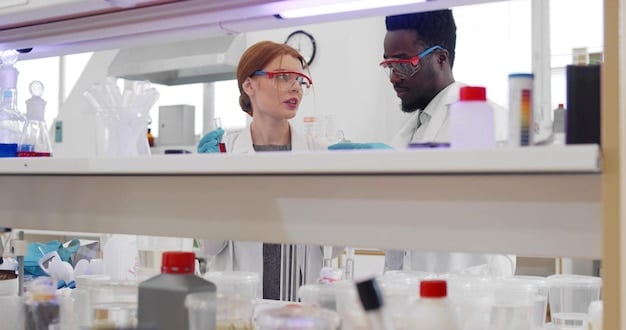Breaking: FDA Approves New Cancer Treatment – Availability & Cost

The FDA has recently approved a new breakthrough cancer treatment showing promising results; this article delves into the specifics of the treatment, its availability, and the expected costs for patients in the US.
In a landmark decision, the FDA has approved a new breaking: FDA Approves New Breakthrough Cancer Treatment – Availability and Cost Details that’s giving hope to patients and healthcare providers alike; let’s discuss the specifics of this groundbreaking therapy.
Understanding the FDA’s Approval of the New Cancer Treatment
The recent FDA approval marks a significant milestone in cancer treatment. This decision follows rigorous clinical trials and evaluations, ultimately greenlighting a therapy that has shown remarkable potential in combating certain types of cancer.
The journey of a new cancer treatment from initial research to FDA approval is a complex and lengthy process. It involves extensive preclinical studies, followed by multiple phases of clinical trials to assess the treatment’s safety and efficacy. The FDA’s approval signifies that the treatment has met stringent standards and offers a favorable benefit-risk profile for patients.

Significance of FDA Approval
FDA approval is not merely a regulatory formality; it’s a testament to the treatment’s potential to improve patient outcomes and quality of life, but what does this mean for patients and the broader healthcare landscape?
- Rigorous Evaluation: The FDA’s review process ensures that the treatment has undergone thorough scrutiny, minimizing potential risks.
- Access to Innovation: Approval opens doors for patients to access cutting-edge treatments that may offer new hope when other options have been exhausted.
- Standard of Care: FDA-approved treatments often become the new standard of care, influencing treatment guidelines and clinical practices across the country.
In conclusion, understanding the significance of the FDA’s approval provides context for the excitement surrounding this new cancer treatment and its potential impact on patients in the US.
Details of the Breakthrough Cancer Treatment
This innovative cancer therapy leverages the latest advancements in medical science to target cancer cells with greater precision, minimizing harm to healthy tissues. So, what exactly makes this treatment so groundbreaking?
The particulars of this treatment varies depending on the type of cancer it addresses, which means patients should look to their oncologists for a qualified medical opinion.
How the Treatment Works
This novel approach may disrupt cancer cells growth by targeting specific molecular pathways, or enhance the body’s own immune system to recognize and destroy cancer cells.
- Targeted Therapy: By focusing on specific molecules involved in cancer growth, the treatment can minimize side effects.
- Immunotherapy: Harnessing the power of the body’s immune system to fight cancer can lead to durable and long-lasting responses.
- Personalized Approach: The treatment may be tailored to individual patients based on their unique genetic and tumor characteristics.
Wrapping up, the introduction of precision and personalized medicine into cancer treatment offers new hope for patients seeking safer and more effective therapies.

Availability of the New Cancer Treatment in the US
Following FDA approval, the focus shifts to ensuring that the treatment reaches the patients who need it most. Here’s what we know about the treatment’s availability within the United States.
The success of this treatment hinges on its accessibility to patients. This includes factors such as manufacturing capacity, distribution networks, and insurance coverage.
Timeline for Availability
While the exact timeline may vary, here’s what patients can typically expect regarding the treatment’s rollout.
- Hospital Implementation: Major cancer centers and hospitals are often among the first to offer the treatment, as they have the infrastructure and expertise to administer it safely.
- Physician Training: Healthcare professionals may require specific training to administer the treatment effectively, which could impact the speed of adoption in different regions.
- Insurance Coverage: The extent of insurance coverage can influence access to the treatment, as patients may face out-of-pocket expenses if it is not fully covered.
To summarize, the timely availability of the new cancer treatment is crucial to maximizing its impact and ensuring that patients across the US can benefit from this medical advancement, always check the official government website or contact your physician for specifics.
Cost Considerations and Insurance Coverage
Understanding the financial aspects of new cancer treatments is essential for patients and their families. The cost of cancer care can be a significant burden, but what financial support is available?
The landscape of healthcare costs is complex, but the cost of the new treatment is affected by manufacturing expenses, research and development expenses, and market-based pricing. Insurance plays an important role in reducing the burden, therefore, seek a medical opinion and a cost analysis.
Navigating Insurance Coverage
This is how patients can navigate how insurance companies typically approach coverage decisions for new cancer treatments.
- Prior Authorization: Insurers may require prior authorization before approving coverage for the treatment, which involves documentation of medical necessity and treatment guidelines.
- Tiered Coverage: Some insurance plans may place the treatment in a higher cost-sharing tier, requiring patients to pay a larger portion of the expenses.
- Appeals Process: If coverage is denied, patients have the right to appeal the decision and provide additional information to support their case.
To conclude, addressing cost considerations and ensuring adequate insurance coverage are critical steps in making the new cancer treatment accessible to all patients who could benefit from it. Seek advice from a professional oncologist before making any decision.
Patient Support Programs and Financial Assistance
Beyond insurance coverage, additional resources are available to help patients manage the financial challenges of cancer treatment. Here’s how families can seek financial support, and what to consider when doing so.
For example, pharmaceutical companies and non-profit organizations commonly provide patient assistance programs. These programs often offer funding and support for patients.
Exploring Assistance Options
Here’s how patients can explore and navigate external support programs.
- Co-pay Assistance: Many pharmaceutical companies offer co-pay assistance programs to help eligible patients with out-of-pocket expenses.
- Non-Profit Organizations: Organizations like the American Cancer Society and the Leukemia & Lymphoma Society offer financial aid and support to cancer patients.
- Government Programs: Government programs like Medicaid may provide coverage for low-income individuals and families facing financial hardship due to cancer treatment.
In summary, exploring patient support programs and accessing financial assistance resources can alleviate the financial burden of cancer treatment and improve access to care for patients across the US.
Future Implications and Research Directions
The approval of this breakthrough cancer treatment not only impacts current patient care but also paves the way for future advancements in oncology. Let’s discuss.
This medical breakthrough serves as a catalyst for continued research, spurring innovation and refining therapeutic approaches. With that, the FDA’s choice serves as evidence of scientific advancement in cancer treatment.
Expanding Treatment Options
Here’s how patients stand to benefit.
- Combination Therapies: Researchers are exploring the potential of combining the new treatment with other therapies, such as chemotherapy or radiation, to improve outcomes.
- Biomarker Identification: Identifying biomarkers that predict response to treatment can help personalize therapy and optimize patient outcomes.
- Long-Term Monitoring: Ongoing monitoring of patients receiving the new treatment is essential for assessing its long-term effects and identifying any potential adverse reactions.
In conclusion, continued research and innovation in cancer treatment hold the promise of improving patient outcomes, reducing side effects, and ultimately transforming the fight against cancer, always search for a qualified oncologist before deciding what treatment is right for you.
| Key Point | Brief Description |
|---|---|
| 🔬 FDA Approval | Treatment meets stringent efficacy and safety standards. |
| 💸 Cost Factors | Include manufacturing cost, R&D, and market-based prices. |
| 🛡️ Insurance Coverage | May require prior authorization or place treatment in a high-cost tier. |
| 🤝 Patient Programs | Co-pay assistance, non-profit support, and government aid are available. |
Frequently Asked Questions
▼
The new cancer treatment is a breakthrough therapy that has shown promising results in clinical trials. Seek medical advice for more info.
▼
The treatment targets cancer cells with precision, either by disrupting their growth or enhancing the body’s immune response.
▼
The treatment is expected to be rolled out in the coming months, starting with major cancer centers and hospitals.
▼
Support programs include co-pay assistance, non-profit organizations, and government programs to help cover treatment costs.
▼
Patients should seek prior authorization, understand tiered coverage, and be prepared to appeal coverage denials with supporting information.
Conclusion
The FDA’s approval of this new cancer treatment represents a significant step forward in oncology, offering hope to patients and driving future research directions aimed at improving outcomes and quality of life.





